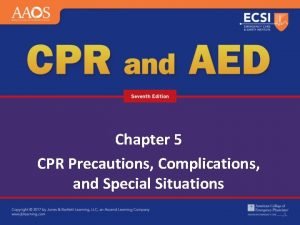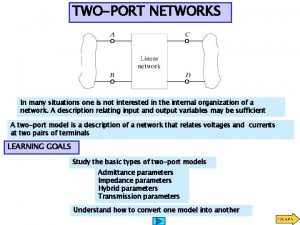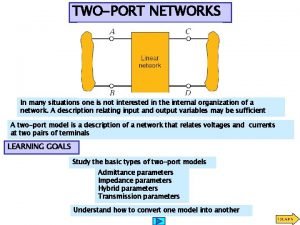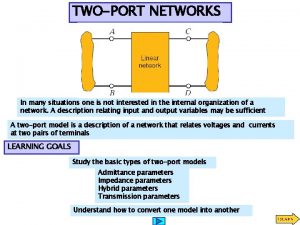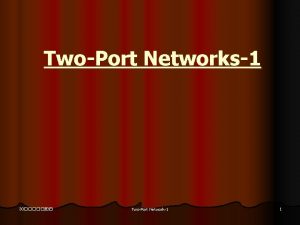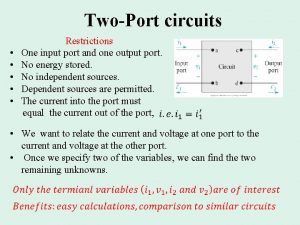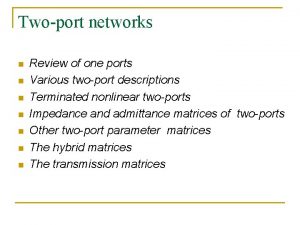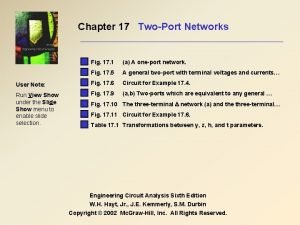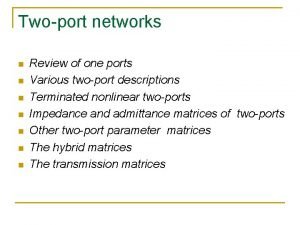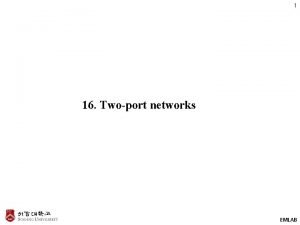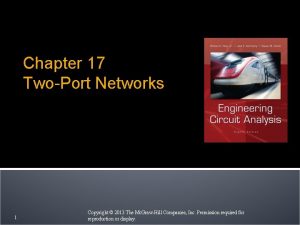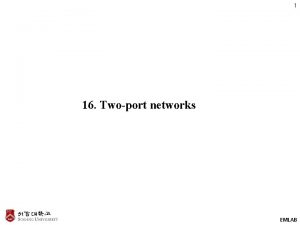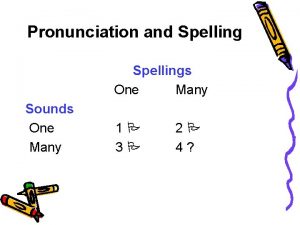TWOPORT NETWORKS In many situations one is not




















- Slides: 20

TWO-PORT NETWORKS In many situations one is not interested in the internal organization of a network. A description relating input and output variables may be sufficient A two-port model is a description of a network that relates voltages and currents at two pairs of terminals LEARNING GOALS Study the basic types of two-port models Admittance parameters Impedance parameters Hybrid parameters Transmission parameters Understand how to convert one model into another

ADMITTANCE PARAMETERS The network contains NO independent sources The admittance parameters describe the currents in terms of the voltages The first subindex identifies the output port. The second the input port. The computation of the parameters follows directly from the definition

LEARNING EXAMPLE Find the admittance parameters for the network Next we show one use of this model

An application of the admittance parameters The model plus the conditions at the ports are sufficient to determine the other variables. Determine the current through the 4 Ohm resistor

IMPEDANCE PARAMETERS The network contains NO independent sources The ‘z parameters’ can be derived in a manner similar to the Y parameters

LEARNING EXAMPLE Find the Z parameters Write the loop equations rearranging

LEARNING EXAMPLE Use the Z parameters to find the current through the 4 Ohm resistor Output port constraint Input port constraint

HYBRID PARAMETERS The network contains NO independent sources These parameters are very common in modeling transistors

LEARNING EXAMPLE Find the hybrid parameters for the network

TRANSMISSION PARAMETERS ABCD parameters The network contains NO independent sources

LEARNING EXAMPLE Determine the transmission parameters

PARAMETER CONVERSIONS If all parameters exist, they can be related by conventional algebraic manipulations. As an example consider the relationship between Z and Y parameters


INTERCONNECTION OF TWO-PORTS Interconnections permit the description of complex systems in terms of simpler components or subsystems The basic interconnections to be considered are: parallel, series and cascade PARALLEL: Voltages are the same. Current of interconnection is the sum of currents The rules used to derive models for interconnection assume that each subsystem behaves in the same manner before and after the interconnection SERIES: Currents are the same. Voltage of interconnection is the sum of voltages CASCADE: Output of first subsystem acts as input for the second

Parallel Interconnection: Description Using Y Parameters

Series interconnection using Z parameters SERIES: Currents are the same. Voltage of interconnection is the sum of voltages

Cascade connection using transmission parameters CASCADE: Output of first subsystem acts as input for the second Matrix multiplication does not commute. Order of the interconnection is important

LEARNING EXAMPLE Find the Y parameters for the network

LEARNING EXAMPLE Find the Z parameters of the network Network A Use direct method, or given the Y parameters transform to Z … or decompose the network in a series connection of simpler networks Network B

LEARNING EXAMPLE Find the transmission parameters By splitting the 2 -Ohm resistor, the network can be viewed as the cascade connection of two identical networks Two-Ports
 Virtual circuit network uses
Virtual circuit network uses Basestore iptv
Basestore iptv Scope of decision making
Scope of decision making Do not start cpr in the following situations
Do not start cpr in the following situations Not genuine not true not valid
Not genuine not true not valid Many species one planet one future
Many species one planet one future Find the inverse of function f. a. b. c. d.
Find the inverse of function f. a. b. c. d. One god one empire one emperor
One god one empire one emperor One one one little dog run
One one one little dog run One king one law one faith
One king one law one faith One empire one god one emperor
One empire one god one emperor Ford one plan
Ford one plan See one do one teach one
See one do one teach one One price policy
One price policy Twelfth night speeches
Twelfth night speeches See one do one teach one
See one do one teach one Asean tourism strategic plan
Asean tourism strategic plan Graphic organizer with the aims of la liga filipina
Graphic organizer with the aims of la liga filipina Many buyers and sellers
Many buyers and sellers Relationship chart
Relationship chart Unary many to many
Unary many to many



